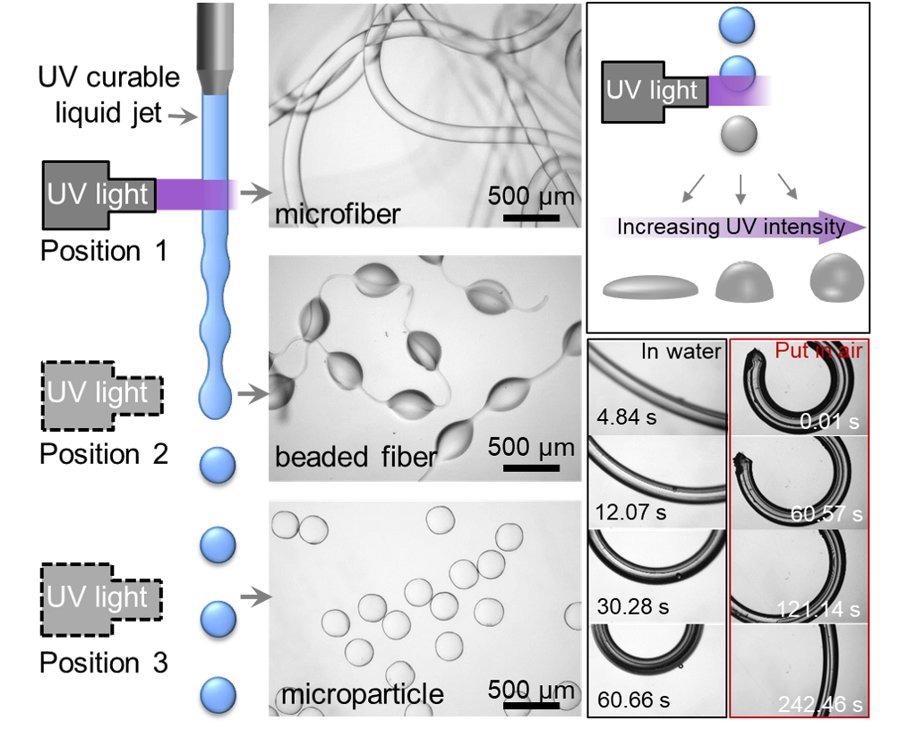Dec 7 2020
Researchers can now produce microfibers, microlenses, and microspheres by irradiating a fluid jet with ultraviolet light. The outcome is the formation of a polymer, locally, with the preferred shape.
 Depending on the location of the UV irradiation of the liquid jet, fibers, beaded fibers or microparticles are formed. Image Credit: University of Twente.
Depending on the location of the UV irradiation of the liquid jet, fibers, beaded fibers or microparticles are formed. Image Credit: University of Twente.
Dubbed “in-air photopolymerization,” this process allows the manufacture of an extensive array of bio-inspired microparticles. The approach is quicker compared to prevailing techniques and generates particles of highly constant quality. Twente researchers have described their study in a paper published in Advanced Materials on December 4th, 2020.
Bio-inspired materials have attracted high demand in several applications such as microparticles stimulating blood circulation or enhancing vaccine delivery, patches with microneedles for painless injection, microfibers that attach themselves to the human body, and microlenses that mimic the eyes of insects.
This necessitates building blocks that are very well-defined and can be assembled in enormous quantities. However, these manufacturing processes are very slow, laborious, challenging to customize, or exhibit increased size deviation.
The particles can be created using lab-on-a-chip technology, which is highly accurate but not quick enough, or by using chemical etching methods that require multiple processing steps. The researchers have demonstrated in the study that the preferred particles can be exactly produced from an ongoing liquid stream, at the rate of up to 4000 particles per second.
UV Irradiation “on the Flow”
Initially, it appears like inkjet printing—a liquid jet is ejected out of a nozzle and the continuous flow breaks down into droplets. However, in this study, the researchers do not wait for the liquid to hit a surface, shaping shapes or letters. They irradiate the fluid with ultraviolet light while it is on its way. The liquid forms a polymer exactly at that spot and solidifies.
What material we create, is determined by the location. If we illuminate the liquid jet (of polyethylene glycol diacrylate) while it is still continuous, we can create fibers. If the jet breaks up in droplets, we can make microspheres. Using pulsed light, we can create fibers of a length that is very well determined.
Jieke Jiang, Study First Author, University of Twente
“Apart from that, we are able to ‘play’ with the chemistry. By adding polyurethane, for example, we can make stronger fibers. We are able to control of all of these properties in a very precise way,” added Jiang.
Janus Fibers
Through this process, researchers can even develop hollow fibers or “Janus fibers”—similar to the Janus head that includes two faces, it combines two materials. This is feasible through the illumination of not just one but two liquid jets at the same place.
Two materials can be used to make active fibers that can respond to stimuli. Moreover, the method exhibits the ability to develop well-defined microlenses that can improve the energy efficiency of solar cells or enhance the yield of LED displays.
Iamfluidics
Previously, the Twente researchers described an approach for printing gels, by enabling two liquid jets to combine.
We called this ‘in-air microfluidics’, and the polymerization technique we now developed, is a new version of it. The technology led to the IamFluidics company, aiming at sustainable microparticles for pharmaceutics, life sciences and cosmetics, avoiding the use of plastics. On the longer term, we expect it will be possible to use particles for printing living tissue, for tissue engineering for example.
Claas Willem Visser, Study Team Leader, University of Twente
The study was performed in the Engineering Fluid Dynamics group of Prof. Kees Venner, Faculty of Engineering Technology, together with Harvard Medical School in Boston, USA.
Journal Reference:
Jiang, J., et al. (2020) Continuous High‐Throughput Fabrication of Architected Micromaterials via In‐Air Photopolymerization. Advanced Materials. doi.org/10.1002/adma.202006336.